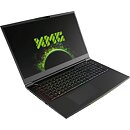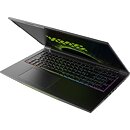Raevenlord
News Editor
- Joined
- Aug 12, 2016
- Messages
- 3,755 (1.22/day)
- Location
- Portugal
| System Name | The Ryzening |
|---|---|
| Processor | AMD Ryzen 9 5900X |
| Motherboard | MSI X570 MAG TOMAHAWK |
| Cooling | Lian Li Galahad 360mm AIO |
| Memory | 32 GB G.Skill Trident Z F4-3733 (4x 8 GB) |
| Video Card(s) | Gigabyte RTX 3070 Ti |
| Storage | Boot: Transcend MTE220S 2TB, Kintson A2000 1TB, Seagate Firewolf Pro 14 TB |
| Display(s) | Acer Nitro VG270UP (1440p 144 Hz IPS) |
| Case | Lian Li O11DX Dynamic White |
| Audio Device(s) | iFi Audio Zen DAC |
| Power Supply | Seasonic Focus+ 750 W |
| Mouse | Cooler Master Masterkeys Lite L |
| Keyboard | Cooler Master Masterkeys Lite L |
| Software | Windows 10 x64 |
XMG's NEO 15 and NEO 17 receive a significant performance upgrade: initially available with the Intel Core i7-10750H with six cores, the NEO model series can now be configured with the eight-core Intel Core i7-10875H. The application of liquid metal thermal compound will continue to ensure optimal processor cooling and consequently lower fan speeds. In their top configuration, both gaming laptops utilize NVIDIA's GeForce RTX 2070 SUPER, with the XMG NEO 17 also featuring a larger 62 Wh battery.
Whilst up to now available with the sole option of an Intel Core i7-10750H, the NEO range will soon be available with over 25% more processing power. The Core i7-10875H offers eight physical cores, 16 threads and a basic and boost clock rate of 2.3 and up to 5.1 GHz respectively. The upgrade is especially beneficial in multi-core-optimized scenarios, but will also ensure that the 15.6- and 17.3-inch gaming laptops are future-proof in terms of performance in upcoming game titles. In CineBench R20, the XMG NEO 15 with Core i7-10875H scores 4,192 points, clearly outperforming the i7-10750H with 3,352 points.


Liquid metal thermal compound provides the decisive temperature advantage
The existing XMG NEO laptops already use a liquid metal-based thermal compound to ensure the best possible processor temperatures and noise-optimized operation even under continuous load. However, XMG has so far held back on naming the manufacturer. With the introduction of eight-core processors in the XMG NEO range, the company has announced that it has historically, and will continue to use Thermal Grizzly Conductonaut. Even in comparison to high-quality silicone thermal compounds, the liquid metal is capable of significantly reducing processor temperatures under full load. In Prime95 stress tests, the maximum CPU temperature of an Intel Core i7-10875H in the XMG NEO 15 was reduced from 91 to 83 °C. However, as usual, the results and measured value differences can vary between individual CPUs.
To overcome one of the biggest concerns about the use of liquid metal, the processor substrate is fitted with a special foam material which, if necessary, absorbs the liquefied heat-conducting material and prevents leakage. A particularly strict quality control regarding the flatness of the heat sink ensures that the cooling system and liquid metal work together at optimum contact and pressure. The cold plate of the CPU heatsink is nickel-plated, thus preventing any undesired chemical reactions between copper and liquid metal. In addition, Thermal Grizzly's Conductonaut excels in terms of long-term durability: even after several years of intensive use of the XMG NEO, the thermal solution retains its first-class cooling performance, with no need to reapply - unlike when using silicone-based thermal compounds.

XMG NEO 17 gets a larger battery
While the XMG NEO 17 was previously only available with a screw-fixed 46 Wh battery, the Leipzig-based laptop manufacturer has now upgraded this, providing the 17.3-inch laptop with a new 62 Wh power unit. However, the king of capacity within the series is still the XMG NEO 15, with an impressive 93 Wh.
XMG NEO 15 and NEO 17: Compact high-performance laptops
On the GPU side, the XMG NEO series continues to utilize NVIDIA graphics cards in Max-P full configuration, which each run the maximum TGP of up to 115 watts. Depending on individual performance requirements, XMG offers the GeForce RTX 2060 Refresh, RTX 2070 Refresh and RTX 2070 SUPER; the latter being an excellent choice even for demanding VR and 4K gaming. The powerful GPUs are highly complimented by the factory pre-calibrated IPS display with Full HD resolution, with the panel operating at a refresh rate of 240 Hz. Both models have a MUX switch, so NVIDIA Optimus can be disabled or enabled upon command. Another common feature of the laptops is a strong chassis with an aluminium display lid. While the top shell of the XMG NEO 15 utilises this light and durable metal, the XMG NEO 17 uses ABS polymer with a non-slip surface.

An additional special feature is the precise, opto-mechanical keyboard with tactile silent switches, 1mm actuation point, 2mm total key travel distance and per-key RGB illumination. A Microsoft precision-compliant glass touchpad is also integrated. Up to 64 GB DDR4-2933 SO-DIMM memory, two M.2 slots and a generous compliment of external interface connections round off the profile of the laptops; these include three USB 3.2 ports, HDMI, Gigabit LAN, WiFi 6, an SD card reader, separate jack sockets for microphone and headset as well as Thunderbolt 3 with two DisplayPort streams for connecting additional external monitors.

Availability information
The XMG NEO 15 and XMG NEO 17 gaming laptops with the new Core i7-10875H, which can be freely configured at bestware.com, can be pre-ordered immediately and will be delivered from early September. The XMG NEO 17 will from now on only be available with the eight-core CPU at prices starting from € 1,753.64 (incl. 16% VAT, different tax rates may apply in some countries). The base configuration of the XMG NEO 15, whose starting price is € 1,607.42, will retain the Intel Core i7-10750H option; however an upgrade to the more powerful i7-10875H is paired with GPU options starting from the NVIDIA GeForce RTX 2070. The rest of the entry configuration includes an NVIDIA GeForce RTX 2060 refresh, 8 GB DDR4 RAM and a 250 GB Samsung SSD 860 Evo in M.2 form factor.
View at TechPowerUp Main Site
Whilst up to now available with the sole option of an Intel Core i7-10750H, the NEO range will soon be available with over 25% more processing power. The Core i7-10875H offers eight physical cores, 16 threads and a basic and boost clock rate of 2.3 and up to 5.1 GHz respectively. The upgrade is especially beneficial in multi-core-optimized scenarios, but will also ensure that the 15.6- and 17.3-inch gaming laptops are future-proof in terms of performance in upcoming game titles. In CineBench R20, the XMG NEO 15 with Core i7-10875H scores 4,192 points, clearly outperforming the i7-10750H with 3,352 points.


Liquid metal thermal compound provides the decisive temperature advantage
The existing XMG NEO laptops already use a liquid metal-based thermal compound to ensure the best possible processor temperatures and noise-optimized operation even under continuous load. However, XMG has so far held back on naming the manufacturer. With the introduction of eight-core processors in the XMG NEO range, the company has announced that it has historically, and will continue to use Thermal Grizzly Conductonaut. Even in comparison to high-quality silicone thermal compounds, the liquid metal is capable of significantly reducing processor temperatures under full load. In Prime95 stress tests, the maximum CPU temperature of an Intel Core i7-10875H in the XMG NEO 15 was reduced from 91 to 83 °C. However, as usual, the results and measured value differences can vary between individual CPUs.
To overcome one of the biggest concerns about the use of liquid metal, the processor substrate is fitted with a special foam material which, if necessary, absorbs the liquefied heat-conducting material and prevents leakage. A particularly strict quality control regarding the flatness of the heat sink ensures that the cooling system and liquid metal work together at optimum contact and pressure. The cold plate of the CPU heatsink is nickel-plated, thus preventing any undesired chemical reactions between copper and liquid metal. In addition, Thermal Grizzly's Conductonaut excels in terms of long-term durability: even after several years of intensive use of the XMG NEO, the thermal solution retains its first-class cooling performance, with no need to reapply - unlike when using silicone-based thermal compounds.

XMG NEO 17 gets a larger battery
While the XMG NEO 17 was previously only available with a screw-fixed 46 Wh battery, the Leipzig-based laptop manufacturer has now upgraded this, providing the 17.3-inch laptop with a new 62 Wh power unit. However, the king of capacity within the series is still the XMG NEO 15, with an impressive 93 Wh.
XMG NEO 15 and NEO 17: Compact high-performance laptops
On the GPU side, the XMG NEO series continues to utilize NVIDIA graphics cards in Max-P full configuration, which each run the maximum TGP of up to 115 watts. Depending on individual performance requirements, XMG offers the GeForce RTX 2060 Refresh, RTX 2070 Refresh and RTX 2070 SUPER; the latter being an excellent choice even for demanding VR and 4K gaming. The powerful GPUs are highly complimented by the factory pre-calibrated IPS display with Full HD resolution, with the panel operating at a refresh rate of 240 Hz. Both models have a MUX switch, so NVIDIA Optimus can be disabled or enabled upon command. Another common feature of the laptops is a strong chassis with an aluminium display lid. While the top shell of the XMG NEO 15 utilises this light and durable metal, the XMG NEO 17 uses ABS polymer with a non-slip surface.

An additional special feature is the precise, opto-mechanical keyboard with tactile silent switches, 1mm actuation point, 2mm total key travel distance and per-key RGB illumination. A Microsoft precision-compliant glass touchpad is also integrated. Up to 64 GB DDR4-2933 SO-DIMM memory, two M.2 slots and a generous compliment of external interface connections round off the profile of the laptops; these include three USB 3.2 ports, HDMI, Gigabit LAN, WiFi 6, an SD card reader, separate jack sockets for microphone and headset as well as Thunderbolt 3 with two DisplayPort streams for connecting additional external monitors.

Availability information
The XMG NEO 15 and XMG NEO 17 gaming laptops with the new Core i7-10875H, which can be freely configured at bestware.com, can be pre-ordered immediately and will be delivered from early September. The XMG NEO 17 will from now on only be available with the eight-core CPU at prices starting from € 1,753.64 (incl. 16% VAT, different tax rates may apply in some countries). The base configuration of the XMG NEO 15, whose starting price is € 1,607.42, will retain the Intel Core i7-10750H option; however an upgrade to the more powerful i7-10875H is paired with GPU options starting from the NVIDIA GeForce RTX 2070. The rest of the entry configuration includes an NVIDIA GeForce RTX 2060 refresh, 8 GB DDR4 RAM and a 250 GB Samsung SSD 860 Evo in M.2 form factor.
View at TechPowerUp Main Site

